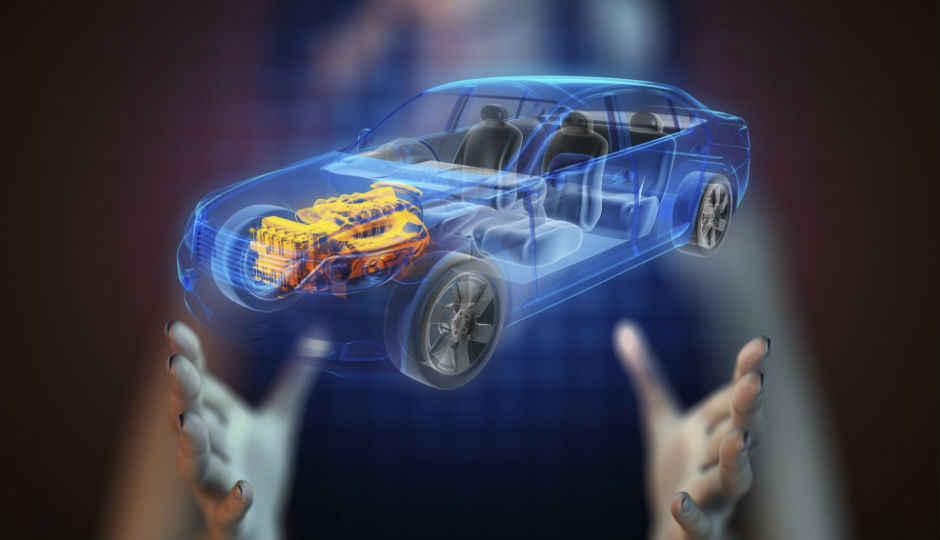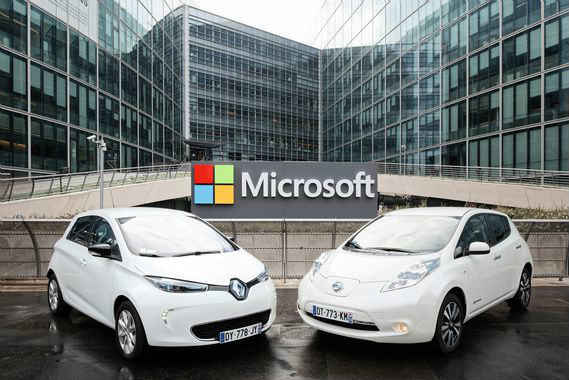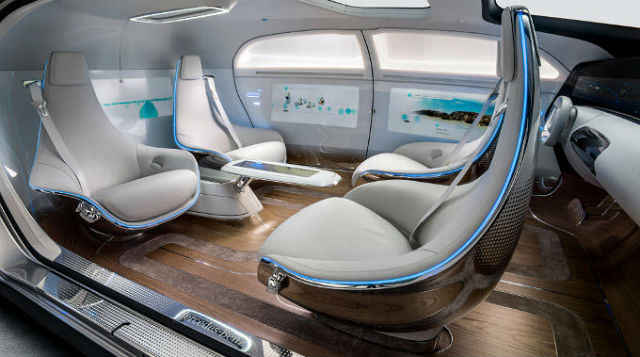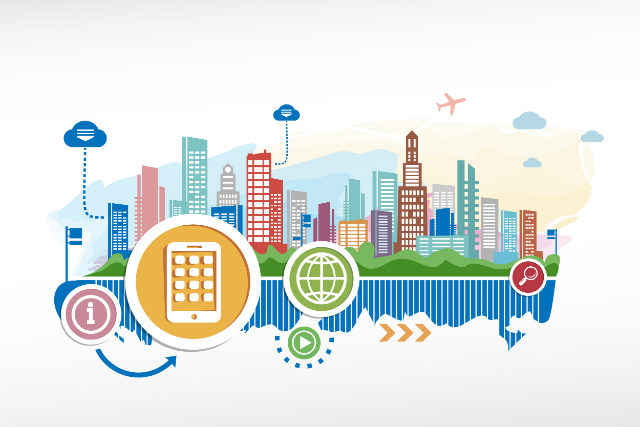How technology and auto companies are coming together for a self-driven, connected future

The tech giants now have a much bigger role to play than infotainment systems, and will be more responsible for a vehicle than automakers themselves.
Up until now, we have written and rewritten extensively about how autonomous driving and connected vehicles are the way forward for the automotive industry. Technology companies are working extensively on automotive projects driven by powerful processor boards, artificially intelligent and increasingly complex algorithms, imaging components and elaborate services, to bring forth vehicles that will redefine in-car luxuries, alter the way we drive and give automobile giants a new industry altogether.
With research going on internationally, the Indian automotive industry has so far had a quieter time in terms of the innovation and research. Popular consensus points at Indian roads not being ideal for self-driving vehicles, with unclear lane demarcations, narrow alleys and difficult traffic situations. But, with the volumes that the Indian auto industry produces, companies are bound to focus more on this market. Development, as it seems, has already been progressing.
The important role of tech giants
There are a lot of obstacles still to be overcome, and a lot of processes yet to be developed further before we attain the levels of autonomy as certified by the Society of Automobile Engineering. To attain this point, technology and auto companies must coexist. As Dr. Timothy Leverton, President and Head of Advanced and Product Engineering of Tata Motors tells us, “The execution of autonomous vehicles is a hugely complex task which places demands on OEMs and their suppliers and development partners as well as regulators. We can expect the emergence of autonomous technologies to begin with increasing use of driver assistance systems into vehicles, collection of traffic data and its analysis, and the definition of initially small dedicated areas and routes for autonomous vehicle function.” These small, dedicated areas of focus is where technology companies are stepping in. The new role of tech companies will not be to just outsource secondary elements in vehicles. Instead, technology will be the primary driver in our future vehicles, which is where these companies will play a significantly more intrinsic role.
There will also be definite partitions in this synergy of auto companies. Radha Rajappa, Services Head at Microsoft India, clearly states, “Microsoft is not building its own connected car. Instead, we want to help automakers create connected car solutions that fit seamlessly with their brands, address their customers’ unique needs, competitively differentiate their products and generate new and sustainable revenue streams. Our customers have shared that they want to work with a partner that not only offers the right tools, but also allows them to keep their data, has a secure and compliant cloud platform, and operates at a truly global scale (given that most automotive brands operate in more than one country).”
“85 percent of Fortune 500 companies already rely on Microsoft’s cloud for these reasons.”
Prakash Mallya, Managing Director, Sales & Marketing Group India at Intel Technology India Pvt. Ltd., subsidiary of Intel Corporation, has an objective answer to the question of tech and auto companies being on a collision course. He highlights the importance and states, “The autonomous driving industry requires multiple levels of expertise, and our acquisitions and collaborations are in line with that understanding. For instance, Intel’s mapping and infrastructure assets in data centers, artificial intelligence and machine learning, complements Mobileye’s assets in hardware and simulators. By putting all of that together we are able to provide an end-to-end solution for autonomous driving – from car to data center.”
From each of their explanations, there is a clear trait – the objective is too large for tech companies to make their own production vehicles. Similarly, auto companies will have to rely on technology innovators rather than developing their own infrastructure from ground. Not only does this save a lot of investment, but the fields of autonomous driving involve neural networks, deep learning, advanced imaging and sensing and cognitive science, all of which are well beyond the purview of car makers. On top of that, technology companies already have established networks for autonomous driving technologies to evolve on. For instance, the Microsoft Azure cloud network is an existing infrastructure that auto companies are already working on to power the connected car ecosystem. With Intel’s data center prowess and AI achievements, using the existing data rendering technology in cars make operations more reliable, and it is this that is the way forward for the entire industry of autonomous vehicles.
Shifting to autonomous vehicles
While it is evident that work on autonomous vehicles has been going on extensively, we also tried to explore the possible rate of adoption of the new technology. The key here, it seems, is to give riders the first taste of autonomous cars to rid them of concerns surrounding how efficient these machines will be. As Dr. Leverton says, “There will continue to be a mix of autonomous and conventional vehicles for many years yet. Having personally experienced riding in several autonomous vehicles in the USA the sense of confidence in the technology builds up quickly to give an enjoyable experience.”
This further highlights how autonomous driving will remain a niche for the premium segment of automobiles, at least for the next few years. The initial experiences will remain reserved mostly for the first movers – investors, engineers and patrons along with a select few consumers. It is with the target of breaching the privilege barrier that companies, particularly the technology innovators, are pursuing partnerships with multiple car makers. For instance, as Rajappa elucidates, “Microsoft is already working with global car makers like Renault – Nissan as well as India car giants like Tata Motors to power next-generation, connected vehicles with advanced navigation, predictive maintenance, remote monitoring of car features and more. It has also partnered with Volvo to integrate Skype for Business in Volvo’s 90 Series cars, which will enhance productivity and make joining conference calls from the car a cinch. Another partner is BMW on BMW Connected, the automaker’s personal mobility companion service, to develop a scalable platform based on Microsoft Azure technologies to deliver in-car productivity services through Office 365, as well as intelligent personal assistance for drivers.”
The shift also involves building the necessary roads that support such an ecosystem, along with other factors in mind. The network infrastructure needs to grow manifold if connected cars are expected to thrive. Dr. Rishi Bhatnagar, President of the IET IoT Panel, India, explains the way forward:
“Bandwidth connectivity is growing and we are seeing a spike in per capita bandwidth availability. With the arrival of 5G, things will get even better. Connectivity technology is also improving and we will have more connectivity options available in the near future. This could mean connectivity at various levels for instance at a smart city level, at a block level (with hotspots) or street level.”
Dr. Bhatnagar is also the President of Aeris Communications, a leading provider of AI solutions in the field of in-car autonomy. Looking beyond the need for connected cars, there is also the notion of electric vehicles coming up as mandatory in the horizon, something that India is notably behind at. With all of these technologies in play and the number of companies coming together, the technology-automobile synergy is also providing one major lifestyle upgrade that has not been majorly focused on. That is…
Making luxuries affordable
Over time, it has been evident that cutting edge technology of the present will gradually trickle down to commonplace implementation, become affordable, and eventually make way for newer advances in a particular field. That, pretty much, has been the law of progression. In the field of autonomous driving, meanwhile, the very first thing that comes to mind is how this service is a luxury.
Owing to higher costs of engineering, autonomous technology will first be fit into premium segment cars (which are more expensive at the first place). This, in turn, will lead to commonplace luxury technology, and the trickle-down will follow. Remember seat ventilators in cars?
But, around when do we expect to see the average salaried individual buying a car with all passenger seats? Will technology truly displace all drivers one day? What, alongside, are the challenges to the autonomous dream? Rajappa says, “Today, the car is more than just a ride between two places — it is a hub of activity for daily life. People are looking to have truly connected experiences in their cars so that they can get more done, save time and make life easier. Today, India is already among the largest automobile markets in the world, and it will only continue to grow. In addition, India also has one of the largest mobile and internet user base. With technologies like 4G becoming mainstream – seamless connectivity is a matter of time. And we will see these benefits trickle down to the automotive sector as well.”
“Using IoT, AI and machine learning technologies, Microsoft will provide vehicle owners in India and across the world with a safe, productive and fun driving experience. Tata Motors are using Microsoft’s connected vehicle technologies on Azure intelligent cloud to bring the digital lives of their customers into the cars they drive.”
Tata Motors, one of India’s leading auto makers, is bullish, but acknowledges that it will take time to spread mass awareness. “It is very clear that self driving cars will become an increasing part of our mobility experience. However, the proportion of self driving vehicles will increase gradually and around specific applications and locations. The demonstration and public experience of safe use of autonomous vehicles over some years will re-assure people that the technology can be relied upon. One of the key arguments for autonomous control is the expectation that fewer accidents and risks will be faced by people when the majority of vehicles are controlled this way,” says Dr. Leverton.
Safety concerns
Yet another area where the synergy of technology and automobiles will be of tantamount importance is in safety. Connected vehicles wired to Cloud services and having the necessary powers to drive itself can be a deadly hazard in the hands of a malicious user, which has led to companies like Toyota exploring blockchain as a possible security standard to be undertaken. But, while possible routes are an avenue yet unexplored, a lot of silent work has already been put in to the field of security for connected vehicles.
Sanjay Gupta, Vice President and India Country Manager at NXP Semiconductors, has an elaborate explanation behind the security standards being deployed presently. He says:
The automotive industry is rapidly evolving and cars are slowly transforming from a simple mode of transport to a personalized mobile information hub. Until recently, cars have been isolated from their environment and from the internet, but the Connected Car will soon feature various wireless technologies like V2X communications, telematics, Near Field Communication (NFC) and multi-standard digital broadcast reception, complemented by ADAS systems that implement autonomous driving features.
Modern vehicles are gradually turning into ‘smartphones-on-wheels’, which continuously generate, process, exchange and store large amounts of data. Their wireless interfaces connect the in-vehicle systems of these ‘Connected Cars’ to external networks such as the internet, which forms entry point for hackers, opening the door for remote attacks. Hence, the rapid increase in electronic complexity is potentially making them more vulnerable and giving rise to a new range of threats and hacks.
The big challenge for vehicle manufacturers is therefore to implement solutions that block hackers, with different motivations, resources and skill levels, and using many different attack vectors, in a cost-effective way. NXP is world leader in crypto- and authentication solutions, and has been working towards bringing banking-level security into the automotive world.
Since the potential threat of hacking does exist, security solutions that prevent network compromise and establish user identity have already been successfully applied in areas such as banking and e-identity, and are now available to the automotive market. Hence, NXP put together a framework, consisting of 4 security layers that lead to a highly secure vehicle network:
4 layers in the new age cars:
-Secure interfaces, which connect the vehicle to the external world
-Secure gateway, which provides domain isolation (separating interfaces, infotainment, safety-critical systems etc.)
-Secure network, that provides secure communication between control units (ECUs)
-Secure processing units, that implement all the features of the connected car
Each connected component has its own specific security challenges. The 4+1 framework provides the right level of protection and countermeasures to individually address the security needs for each one. This structured approach delivers multiple levels of defense, from the vehicle’s perimeter to the individual electronic control units (ECUs), eliminating vulnerabilities. The 4 layer security framework provides a holistic approach for securing the complete vehicle architecture, using a defense-in-depth strategy.
The India story
India is still one step behind the advanced nations in terms of autonomous driving technology. But, with technology giants putting heads together globally and working extensively, car makers are also putting more emphasis. The first Indian company set to undertake self-driving tests in India is Tata Motors, under its younger and more experimental TaMo sub-brand. Dr. Leverton affirms, “Tata Motors is actively undertaking R&D work on advanced driver assistance systems (ADAS) as well as full vehicle autonomy. The ADAS features will appear in our vehicles in the next 3 years. We will use the TAMO sub-brand to prove out such features in the market first.”
Advancing the Indian landscape for advanced vehicles also has a lot to do about improving the available infrastructure in our country, which includes improving traffic rules, creating better roads, establishing charging networks, and more importantly, for all the infrastructure to be sustained and promoted into smart cities, the need of better networks. Dr. Leverton echoes the same, stating, “The major challenge to take forward autonomous vehicle technology in India is the availability of data characterising the traffic and infrastructure conditions. The data collection is underway but will take some years. Even the creation of relevant driver assistance systems depends on robust data regarding the application conditions. However, there are already situations where a controlled use of an autonomous vehicle can be imagined for example the BRTS systems being implemented in cities around India.”
Gupta, meanwhile, acknowledges that work is under way, but is still some way from its goal. “A growing economy and rapid urbanisation need a robust urban infrastructure for domestic growth of the automotive sector, which has been boosted by the Smart Cities Mission. One major components of Smart Cities initiative is creating and developing an efficient urban mobility and public transport system that provides a variety of transport options. Connected cars provide seamless connectivity between different electronic systems such as infotainment, control systems, safety features and navigation features through internet within the car as well as with outside systems through Internet of Things (IoT). Connected cars would encourage collaborations between manufacturers of electronic devices used in cars, mobile devices, wearable devices, IT systems integrators as well as ISPs. Therefore, connected cars will play an instrumental role in catalysing the envisaged smart transportation and smart infrastructure leading to further increase in the economic activity in automotive sector in the next decade,” he concludes.
It is evident that the possible innovations in advanced locomotion in India will first roll out to commercial vehicles, while personal commuting with connected, autonomous vehicles is quite some time away. Technology companies, in this space (globally), are playing a significantly more important role than ever before. While automobile companies will continue to “make” cars, the hearts and nerves will be provided by technology, where algorithms will soon be deemed more important than the engine itself.
Our cars will soon get to “see”, “learn”, “react” and “talk”, every necessity of a human driver, and it is the synergy between technology and automobile giants that is making this possible.








